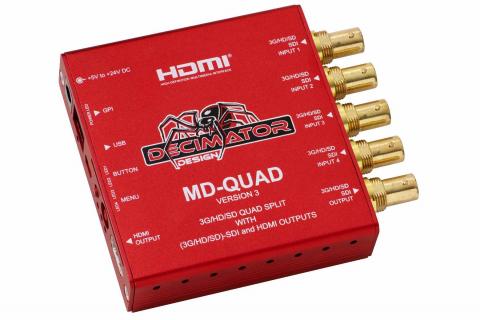
Description
The Decimator MD-QUAD is a Professional 3G/HD/SD Test Pattern Generator featuring 26 Selectable Output Formats, 54 Test Patterns including Luma and Chroma Zone-plates, and an Audio Tone Generator. In Quad-Split mode the first 8-channels of audio from any input can be passed to both the HDMI and SDI output. The Decimator MD-QUAD also includes on-screen audio id pop-up when selection audio source in Quad-Split mode and on-screen display pop-up when using the rotary to allow for use without a PC.
Decimator MD-QUAD features
- Low cost miniature (3G/HD/SD)-SDI 4 to 1 Quad Split or 4 to 1 input multiplexer
- Selectable output format in Quad-Split mode
- Dynamic UMD and Tally support via RS422/485 pins on RJ45 connector
- GPI on RJ-45 for remote switching and Tallies
- Low latency buffering for each input allowing non-synchronous inputs
- Linked (3G/HD/SD)-SDI and HDMI outputs
- 4 x (3G/HD/SD)-SDI inputs with auto detection (26 Formats supported in total)
- 8-Channel Audio metering for each quadrant with:
- The first two audio groups individually selectable
- Vertical or Horizontal Bars
- AES/EBU, VU, Extended VU, BBC, EBU, DIN and NORDIC Scales
- Bar & Float, Bar only or Float only (Float is not available for MQS serials)
- Transparency adjustment
- Separate Bar and Float Ballistics control
- Adjustable Reference level
- Red, Yellow and Green Range adjustment
- Bar thickness adjustment
- Margin adjustment
- Each quadrant is independent of the others, allowing any 3G/HD/SD format of any frame rate to be displayed simultaneously
- Variable aspect ratios per quadrant
- All 4 inputs can be displayed simultaneously on a single output
- Pass-Through mode allowing any of the 4 inputs to be selected for output
- In Pass-Through mode the selected input is passed through to both the (3G/HD/SD)-SDI and HDMI outputs
- On-Screen 16 character IDs (UMDs) for each input
- An extensive selection of user controllable functions via an easy to use rotary encoder for menu selection. LEDs and a push button can then be used for status and control
- USB port for control and updates
- Locking DC Power Socket